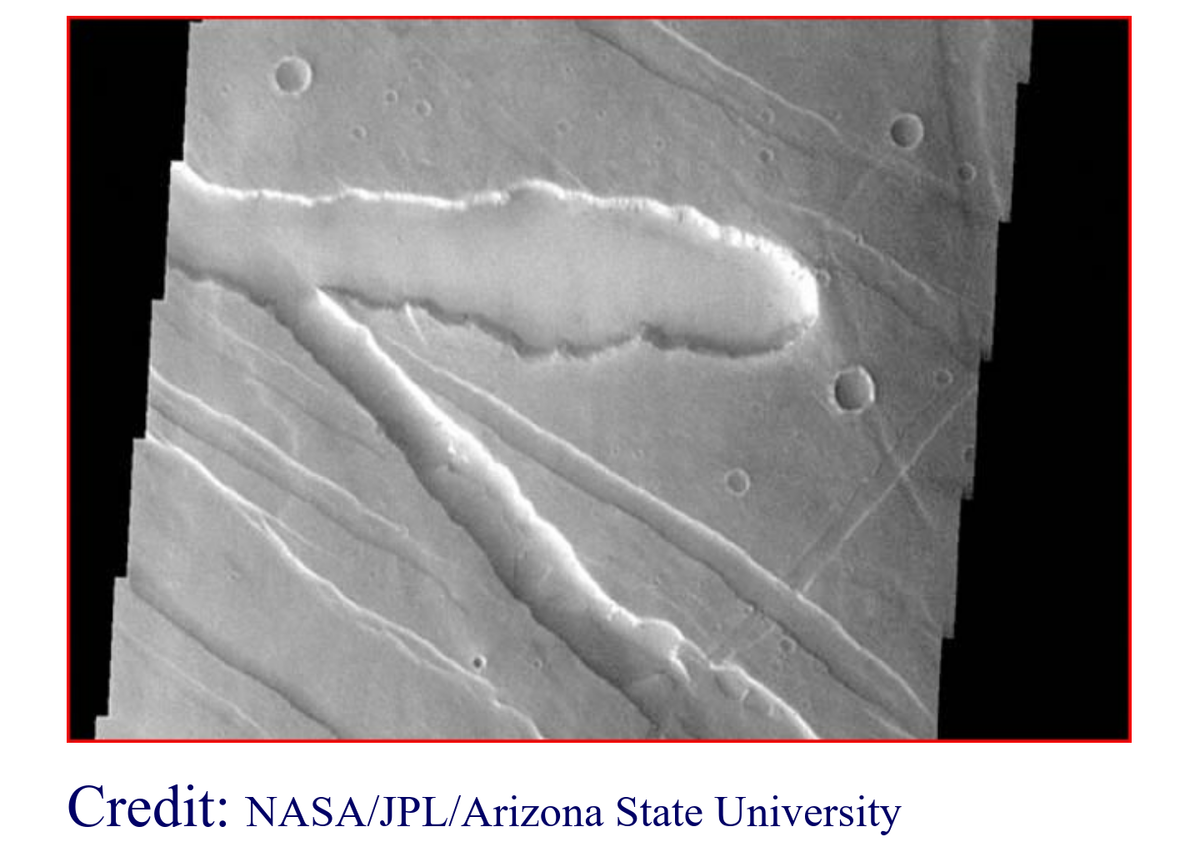ザ・サンダーボルツ勝手連 [Etched Mars エッチングされた火星]
[Etched Mars エッチングされた火星]

―――――――
Aug 11, 2004
火星の表面には、さまざまなサイズのグルーヴ(溝)がエッチングされているように見えます。グルーヴ(溝)は、惑星地質学者達には知られていない力による物質の除去を示しています。 しかし、プラズマ物理学者達にはなじみのある力
―電気アーク加工は
―これらの正確な特性でグルーヴ(溝)をエッチングします。
このようなグルーヴ(溝)は火星の表面にエッチングされているように見えます。
サイズは大きく異なりますが、驚異的な特徴は同じです:
平行で急な側面が、しばしばスカラップ(ホタテ貝状化)し;
平底;
各溝が他の溝に邪魔されない様子の鋭い交差場所;
フラットテラス;
時々介在する地形をスキップして「内陸」の盆地を残す突然の終了;
そして、どこでも、なじみのある侵食プロセスが残すべき破片がないこと。
このグルーヴ(溝)は、惑星地質学者達には知られていない力による物質の除去を示しています。
しかし、プラズマ物理学者達によく知られている力は、これらの正確な特性でグルーヴ(溝)をエッチングします:
電気アーク加工。
この電気力は、アークが90度の角度で表面に接触するように拘束します。
アークは通常、共通の軸を中心に回転する1つまたは複数のチャネルのペアで構成されているため、静止したアークは円形のクレーターをエッチングします。
エッチングされた物質の大部分は表面から持ち上げられ、エッジの周りの物質は鋭い縁にピンチアップ(つまみ上げ)されます。
回転チャネルが十分に離れている場合は、それらは、クレーターの中央に乱されていない物質の「ピーク」を残す可能性があります。
電流の変動により、エッチングの深さと直径が変化し、壁に沿ってテラスが残る場合があります。
アークが表面を横切って移動する場合、均一な深さまで物質をエッチング除去し、アークの回転の幅と正確に平行な側面を持つグルーヴ(溝)を残します。
不均一な動きは、一連の重なり合う円形のクレーターが生じる可能性があり、スカラップエッジ(ホタテ貝状エッジ)、またはアークのジャンプを生成し、クレーターの線形チェーンを生成します。
進行中のアークが前のアークによってエッチングされたグルーヴ(溝)を横切るとき、それは地形の変化の影響を受けません。
時々、以前のグルーヴ(溝)の「ゴースト(幽霊)」は、後のアークがその均一な深さを片側から反対側にエッチングするときに保持されます。
(このような「ゴースト(幽霊)」の例は、画像の右上にあります。)
クレーターチェーンを生成するジャンプと同様のプロセスでは、アークが溝をエッチングし、次に溝をさらにエッチングする前にジャンプして、孤立した盆地の線を残す場合があります。
電気アークエッチングと機械的侵食プロセスを区別する2つの優れた特性は、エッチングによって残された少量の破片と、クレーターとグルーヴ(溝)の床のかなりの溶融です。
火星の特徴の中や周りに破片がないことは、すでに注目されています。
ランダー(着陸探査船)はすぐにガラス化の証拠を報告し始めるはずです。
―――――――
Aug 11, 2004
Grooves of widely varying sizes appear etched on the surface of Mars. The grooves indicate a removal of material by forces unknown to planetary geologists. But a force familiar to plasma physicists
-- electrical arc machining
-- etches grooves with these exact characteristics.
火星の表面には、さまざまなサイズのグルーヴ(溝)がエッチングされているように見えます。グルーヴ(溝)は、惑星地質学者達には知られていない力による物質の除去を示しています。 しかし、プラズマ物理学者達にはなじみのある力
―電気アーク加工は
―これらの正確な特性でグルーヴ(溝)をエッチングします。
Grooves such as these appear etched into the surface of Mars.
このようなグルーヴ(溝)は火星の表面にエッチングされているように見えます。
Although their sizes vary enormously, their outstanding features are the same:
parallel, steep sides, often scalloped;
flat bottoms;
sharp intersections that leave each groove undisturbed by the other;
flat terraces;
sudden terminations that sometimes skip over intervening terrain, leaving "land-locked" basins;
and everywhere an absence of the debris that familiar erosional processes should leave.
サイズは大きく異なりますが、驚異的な特徴は同じです:
平行で急な側面が、しばしばスカラップ(ホタテ貝状化)し;
平底;
各溝が他の溝に邪魔されない様子の鋭い交差場所;
フラットテラス;
時々介在する地形をスキップして「内陸」の盆地を残す突然の終了;
そして、どこでも、なじみのある侵食プロセスが残すべき破片がないこと。
The grooves indicate a removal of material by forces unknown to planetary geologists.
このグルーヴ(溝)は、惑星地質学者達には知られていない力による物質の除去を示しています。
But a force familiar to plasma physicists etches grooves with these exact characteristics:
Electrical arc machining.
しかし、プラズマ物理学者達によく知られている力は、これらの正確な特性でグルーヴ(溝)をエッチングします:
電気アーク加工。
The electrical forces constrain the arc to contact the surface at a 90-degree angle.
この電気力は、アークが90度の角度で表面に接触するように拘束します。
Because the arc typically consists of one or more pairs of channels that rotate around a common axis, a stationary arc will etch a circular crater.
アークは通常、共通の軸を中心に回転する1つまたは複数のチャネルのペアで構成されているため、静止したアークは円形のクレーターをエッチングします。
Most of the etched material is lifted from the surface, and the material around the edge is pinched up into a sharp rim.
エッチングされた物質の大部分は表面から持ち上げられ、エッジの周りの物質は鋭い縁にピンチアップ(つまみ上げ)されます。
If the rotating channels are sufficiently far apart, they may leave a "peak" of undisturbed material in the center of the crater.
回転チャネルが十分に離れている場合は、それらは、クレーターの中央に乱されていない物質の「ピーク」を残す可能性があります。
Fluctuations in the current may cause variations in the depth and diameter of etching, leaving terraces along the walls.
電流の変動により、エッチングの深さと直径が変化し、壁に沿ってテラスが残る場合があります。
If the arc travels across the surface, it will etch away material to a uniform depth and leave a groove with parallel sides exactly the width of the arc's rotation.
アークが表面を横切って移動する場合、均一な深さまで物質をエッチング除去し、アークの回転の幅と正確に平行な側面を持つグルーヴ(溝)を残します。
Uneven movement may result in a series of overlapping circular craters, producing scalloped edges, or a jumping of the arc, producing linear chains of craters.
不均一な動きは、一連の重なり合う円形のクレーターが生じる可能性があり、スカラップエッジ(ホタテ貝状エッジ)、またはアークのジャンプを生成し、クレーターの線形チェーンを生成します。
When a traveling arc crosses the groove etched by a previous arc, it will be unaffected by the change in terrain.
進行中のアークが前のアークによってエッチングされたグルーヴ(溝)を横切るとき、それは地形の変化の影響を受けません。
Sometimes a "ghost" of the earlier groove will be preserved as the later arc etches its uniform depth down one side and up the other.
(An example of such "ghosting" can be seen at upper right in the image.)
時々、以前のグルーヴ(溝)の「ゴースト(幽霊)」は、後のアークがその均一な深さを片側から反対側にエッチングするときに保持されます。
(このような「ゴースト(幽霊)」の例は、画像の右上にあります。)
In a process similar to the jumping that produces crater chains, an arc may etch a groove and then jump a ways before etching more of the groove, leaving lines of isolated basins.
クレーターチェーンを生成するジャンプと同様のプロセスでは、アークが溝をエッチングし、次に溝をさらにエッチングする前にジャンプして、孤立した盆地の線を残す場合があります。
The two outstanding characteristics that distinguish electrical arc etching from mechanical erosion processes are the small amount of debris left by etching and the considerable melting of crater and groove floors.
電気アークエッチングと機械的侵食プロセスを区別する2つの優れた特性は、エッチングによって残された少量の破片と、クレーターとグルーヴ(溝)の床のかなりの溶融です。
The lack of debris in and around features on Mars has already been noticed.
火星の特徴の中や周りに破片がないことは、すでに注目されています。
Landers should soon begin reporting evidence of glassification.
ランダー(着陸探査船)はすぐにガラス化の証拠を報告し始めるはずです。